Diseases & Conditions
Patient Story: Knee Ligament Injuries and Meniscus Tear

On a Sunday afternoon in October of 2012, Nicholas Kennedy was playing a game of flag football with friends. Already favoring his left leg due to a pulled muscle, Nick aggravated his injury again while going in on defense to rush the opposing team. On the next play, Nick was running toward the quarterback. When he took a step to his right, Nick cut back to the left to grab his flag and felt a pop in his knee.
Fortunately, Nick's teammates included four doctors and two medical students, who were able to examine his knee on the field. They determined he had likely torn his fibular collateral ligament (FCL).
The next day, Nick visited Robert LaPrade, MD, PhD, an orthopaedic surgeon and researcher at the Steadman Philippon Research Institute. Dr. LaPrade ordered x-rays and an MRI scan, and diagnosed him with a torn FCL and anterior cruciate ligament (ACL), and a partially torn medial meniscus--a pad of cartilage in the knee.
Nick underwent surgery twelve days after his injury. Dr. LaPrade repaired Nick's ligaments using an autograft technique in which tissue is taken from another part of the patient's body to replace the torn ligaments. Dr. LaPrade also sutured Nick's torn meniscus.
Nick has always been extremely active and competitive in multiple sports. Nick lettered in high school football, baseball, golf, and basketball. He was all-state in football at two positions, kicker and cornerback, and continued to stay active through college. He has run a half marathon, competed in weightlifting and crossfit competitions, and enjoys outdoor activities such as fly fishing and hunting.
"After my injury, I just realized how important my health, or anyone's health, is for allowing them to live life the way they want to live it," Nick says. "Walking was hard. I couldn't bike, walk up stairs, or sit in a seat at an NBA game. I was suddenly unable to do the littlest things that I had taken for granted."

Two days after his surgery, Nick began physical therapy to regain range of motion and prevent the development of scar tissue. Five weeks after surgery, Nick was able to ride his bike, and at six weeks he was permitted to begin weight bearing exercises such as walking, working out in a pool, leg presses, and more. "I am now just very grateful I can start to get back to doing the things I love to do; the things that help me enjoy life," he says.
Nick admits that he's had a few setbacks along the way. Soon after his surgery, a number of airline flights required for medical school interviews increased swelling and inhibited his range of motion. Taking three weeks off from flying helped improve Nick's movement to the point where he was able to walk normally again.
Staying positive is Nick's biggest challenge. He understands that his rehabilitation will proceed more quickly with a positive attitude. "Fifteen to twenty years ago, my kind of injury could have been life-altering," he says. "It could have meant I would never be able to move my knee the same, or compete in sports and athletic activities at the same level. Thanks to research and recent advancements, ligamentous repairs are now showing great follow-ups, and people are able to perform at the exact same, and sometimes higher, level as before their injuries."
Last Reviewed
September 2014
AAOS does not endorse any treatments, procedures, products, or physicians referenced herein. This information is provided as an educational service and is not intended to serve as medical advice. Anyone seeking specific orthopaedic advice or assistance should consult his or her orthopaedic surgeon, or locate one in your area through the AAOS Find an Orthopaedist program on this website.






